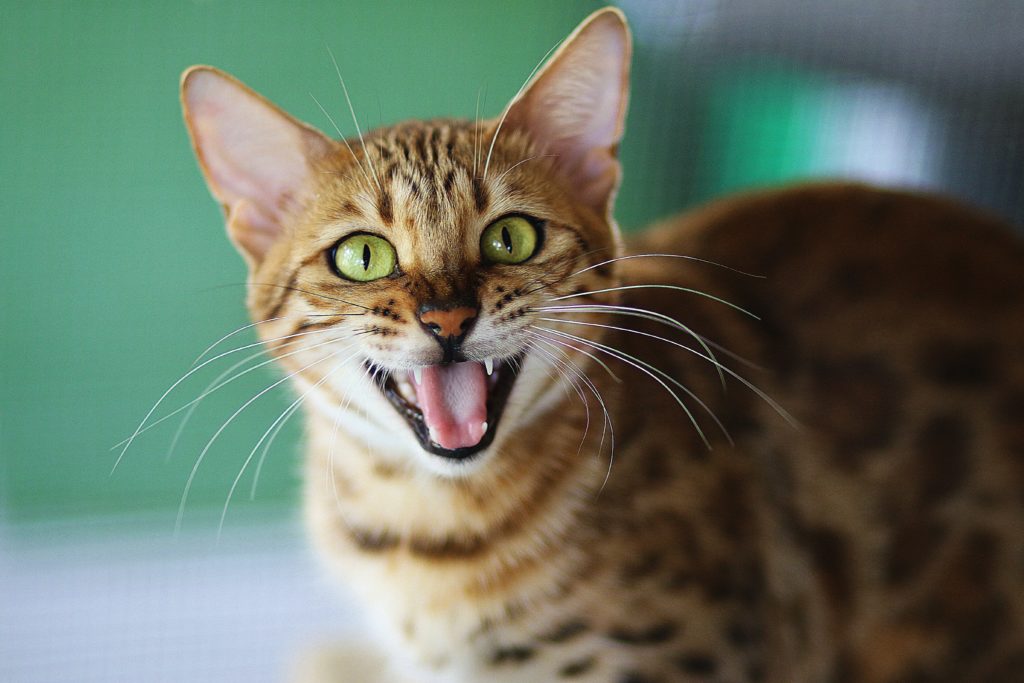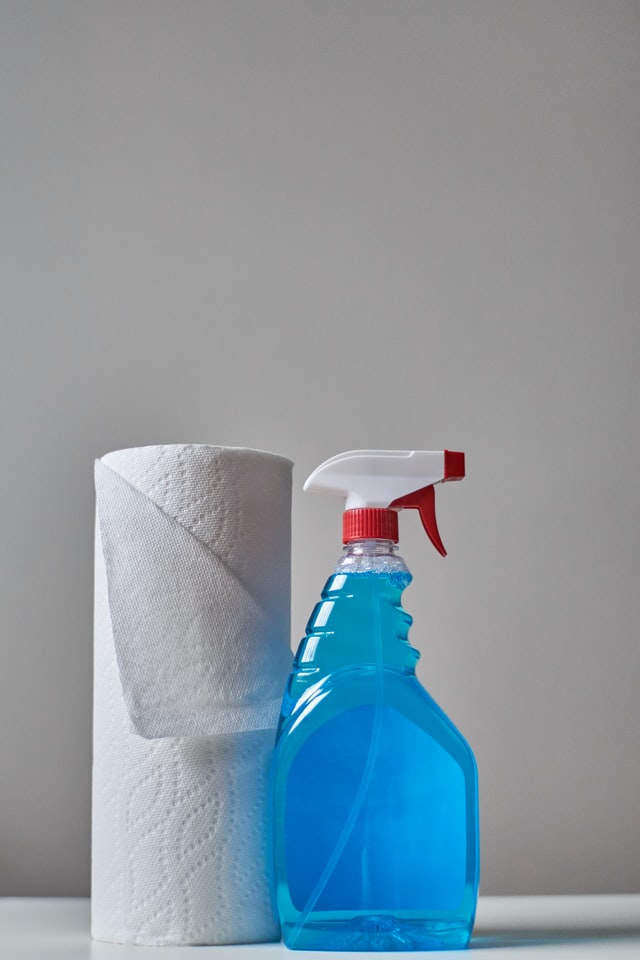“Oh… not again!” No owner wants to deal with their Bengal cat spraying urine around their house.
And for those who have this problem, finding a solution can be time consuming, costly and frustrating.
This article will provide you with seven reasons as to why your Bengal is spraying and what you can do straight away to remedy the situation.
But first, exactly what is spraying?
What Is Spraying?
Spraying is when a cat uses its urine to ‘mark’ an object or area.
In the wild, this practice is believed to have implications with regards to defining a cat’s territory- a form of chemical signalling.
Spraying differs to urinating (for waste reasons) in that usually a cat will adopt a different posture by backing up to the (vertical) area or part of the object that is to be sprayed, with its tail up and hindquarters raised.
I’ve discovered whilst researching this article, that horizontal surfaces, such as a floor, can also be marked, however, this is called ‘urine marking’ and not ‘spraying’ as such.
A urine marking cat will generally squat as it does when on a litter tray.
Spraying (and marking) may also involve much less fluid expulsion than regular peeing.
Although this paper says otherwise…
We’ve established exactly what spraying is, but at what age is this behaviour likely to start…?
When Do Bengal Cats Start Spraying?
Bengals, like other cats, start spraying at around 6 months old, though I have read that for some males, the figure may be lower and in the region of 4 or 5 months.
It all depends on when an individual reaches sexual maturity i.e. the time it is ready to start mating.
Onto the impact a cat’s gender can have…
Do Male and Female Bengal Cats Spray?
Both male and female Bengal cats are capable of spraying.
This Bengal cat spraying behaviour is most common in males, especially non-neutered males.
This research paper states that approximately 10% of the neutered male cats (not necessarily Bengals) and 5% of neutered females studied engaged in spraying.
You may be wondering whether Bengals spray more frequently than other cats…
Do Bengal Cats Spray More Than Other Breeds?
I could find no evidence to suggest that Bengal cats spray more than other cat breeds.
However, I did read that those generations closer to the original cross between an Asian Leopard Cat and a domestic cat- that is F1, F2 and F3 generations are more likely to spray.
This is said to be due to the fact they are genetically and behaviourally more ‘wild’.
This still doesn’t mean an F1, F2 or F3 Bengal will definitely spray.
It’s just perhaps more likely.
Why is My Bengal Cat Spraying?
Below is a list of the most common reasons as to why your Bengal cat is spraying and actions you can take to remedy the situation.
Let’s get to it.
#1: Your Bengal Has Not Been Neutered
Cats start spraying when they reach sexual maturity.
Of course, not all cats or Bengals spray, even if they’ve not been neutered- indeed our own kitten, Hazel, passed the 6 month period and without doing so, although she was clearly interested in mating by ‘displaying’ when we called her name.
What You Can Do
Have your kitten neutered- as this hugely reduces the chances of kittens/cats spraying. The age at which this should be done is variable but usually around the 6 month mark.
If in doubt, ask your breeder or a vet.
If your cat sprays and has been neutered, you need to investigate the next reason with some haste…
#2: There Is An Underlying Health Problem or Medical Issue
Spraying or leaving a urine mark (indeed that passing of urine outside of the litter box) could be the result of an undiagnosed health issue.
Typically, feline lower urinary tract disease (FLUTD), which was formally called feline urologic syndrome (FUS).
FLUTD encompasses a group of conditions that include:
- Inflammation of the bladder (Interstitial Cystitis)
- Bladder Infection
- Bladder Stones
- Urethral obstruction
Associated symptoms to look out for (or that you may notice) include blood in the urine, more frequent urination, lack of appetite alongside some indication that your cat is in pain when urinating or indeed, straining to do so.
Cats with any of the above may urinate outside their litter boxes as a form of disassociation, that is, they associate the litter box with pain, therefore try to avoid using it.
What You Can Do

If your neutered Bengal has suddenly started spraying or peeing in new areas then rule out health problems by visiting a vet.
Having said that, this paper discounts the claim that a medical issue is the cause, but admits more studies are needed before a link can be proven or dismissed.
But some research in turn contradicts this…
With that in mind, why take the risk?
If you have a neutered, healthy Bengal cat that sprays, then consider its environment…
#3: It’s World Has Suddenly Changed
Cats, like many humans, do not deal with change very well.
Adult Bengals, for example, are known to take longer to settle into a new home.
If you’ve moved house, decorated/rearranged furniture, or have a long term (human) visitor, these changes can unsettle your cat and cause it to start spraying.
Spraying offers some sense of comfort and familiarity- therefore it helps to alleviate stress.
What You Can Do
Introduce any necessary changes slowly. In many ways, act as if you were introducing a new kitten to the home.
Place items or objects your pet recognises, especially those covered in its own scent, in new, unfamiliar areas.
Give your Bengal the space and time it needs to adapt. Reduce its territory size by limiting it to a room or two at first- again much as you would with a new kitten.
Now those who own a spraying cat in a multi-cat home have a unique cause to investigate…
#4: There Are Too many Cats In Your Home
Cats are typically solitary animals so in the wild, would not live with other cats.
Research has shown that urination for excretion purposes (latrine behaviour) and spraying, is more likely in homes containing more than one cat. For example this paper.
Exact figures vary according to the study, but roughly over 80% of spraying/marking cats came from multi-cat households.
Reasons for this include competition for space and resources around the home plus the alteration of’ social relationships’.
What You Can Do

Adult Bengals in particular don’t take to new feline house mates particularly well so think carefully before introducing a new cat to your home or a Bengal to a home already with an incumbent.
Bengals need a lot of stimulation so spending more time playing and interacting with them may reduce stress and conflict/aggression shown towards other cats in the household.
Ensure there are enough resources for each cat- and that means food bowls, water, toys and litter trays, plus space for them to be apart.
If you have more than one cat and spraying is a problem, you may need to consider rehoming/reducing numbers as a last resort.
Of course, it may be cats belonging to others that are causing the problem…
#5: Your Bengal Feels Threatened By An Outsider
Many reasons as to why your Bengal may have started spraying are associated with stress- it’s a case of deriving the cause of that stress.
This table shows that in this study, around 60% of cats allowed some kind of outside access indulged in marking/spraying behaviour.

One of the reasons could be linked to contact with outsiders- specifically neighbourhood or unfamiliar cats.
These ‘new’ cats may be perceived as a potential threat by your Bengal.
Therefore, spraying may commence to re-establish territory and form a sense of security.
However, it is worth noting that non-spraying latrine based behaviour was actually more prevalent in house cats with no outside access.
Some sites suggest cats entering the home through cat flaps could be a cause, although the science doesn’t seem to back this up with regards to increased risk of spraying or marking.
What You Can Do
If spraying is a problem and your cat has free access to the outside world, consider restricting this.
Although this may sound difficult, there are in fact are numerous ways this can be achieved:
- ‘Cat proof’ your garden
- Take your Bengal out for walks- see The Best Bengal Cat Harness [2021]
- Build an outdoor run or ‘catio’
If unsure as to whether your Bengal is actually spraying/marking or instead, using an area as a toilet outside of the litter tray, then consider potential issues with the litter tray itself…
#6 The Litter Tray Has Become Undesirable
Cats generally, (and Bengals are no different) prefer clean, large, easily accessible trays.
Advice varies wildly according to what you read, with some saying covered trays give your cat privacy, with others recommending open trays for example.

This is also true when it comes to the litter itself- clumping v non clumping, scented v non-scented etc.
Many recommend having multiple trays/boxes, but again the research is contradictory here too.
What You Can Do
With advice varying, the key here is trial and error.
If urine is suddenly appearing elsewhere and you’re not sure it’s to do with spraying, then consider the following:
- Add another litter tray- perhaps to the area where this new found urine is appearing
- Make it larger and add or remove a lid
- Try a different type of litter
- Remove waste as soon as is practical
- Change litter and clean the whole tray more often
- Move it to a different location
As I’m sure you’ll have gathered by now, introduce changes slowly allowing your cat time to adapt- e.g. if trying new litter, mix a little with the old first and slowly increase the quantity over time.
Our 7th reason involves an honest review about how much activity your Bengal gets to indulge in…
#7 Boredom or Under Stimulation

Cats need stimulation.
Bengal cats are said to need even more stimulation.
Imagine then what a Bengal house cat needs?
If yours isn’t getting enough, then it can lead to that word again, stress.
And in turn, there’s a potential for Bengal cat spraying behaviour.
What You Can Do
Play with your Bengal as much as possible- this is especially necessary if your cat has no outdoor access.
Leave toys and play ‘objects’ lying around to keep your cat occupied if you’re busy and when you’re out (see Best Toys For Bengal Cats [in the world] 2021). Turn a ‘spray area’ into a ‘play area’ (a phrase I’ve just coined, but feel free to use it…).
Enrich your cats living environment by introducing more cat trees, walkways or a cat wheel.
Consider allowing your cat some kind of outdoor access by taking it for walks after it’s been leash trained or by building an outdoor enclosure/catio.
No matter which of the above is the cause, you will still need an effective way of removing all traces of spray in its entirety…
How To Clean Up And Remove Cat Spray
Opinion on this appears to be consistent.

It’s not easy.
That’s because cat spray is particularly pungent and designed to quite literally ‘stick’ around.
Alongside all the methods you can try above to stop your cat from spraying, you’ll need an effective means of cleaning and removing it.
There’s a tendency for cats to ‘re-scent’ the same spots, so removing it discourages your cat from doing so again.
This will require agents that can effectively break down the urine and prevent it from smelling- smelling to a highly sensitive Bengal nose, not just a human one remember.
The PDSA suggests washing the area with some biological washing powder (as the enzymes break down the urine) and warm water followed by scrubbing with surgical spirit/rubbing alcohol to remove the scent.
You can then rinse again with water and let the area dry before allowing your cat near.
Alternatively, you could use an odour neutraliser designed for use on cat urine.
This is important as it should not contain ammonia, as I’ve read on numerous sites that ammonia actually makes the smell worse as urine itself contains yes, ammonia.
In conjunction with the advice given in the ‘What You Can Do’ sections in the list above, it seems the key to stopping a cat spraying in a particular spot is to remove all previous signs and more importantly, smells.
But there are other non-specific options available. Things you can try straight away. And these may also help solve problems of urination outside of the litter tray…
How To Stop A Bengal Cat From Spraying: Generic Tips
- Put a food bowl (or bowls) in spraying locations. Cats are supposed to not like eating and spraying in the same place. And who can blame them?
- Block access to known Bengal cat spraying locations.
- Restrict access to areas they definitely don’t spray in then gradually increase this.
- Douse spraying spots in substances that contain undesirable odours such a citrus. Ensure that whatever you use contain nothing harmful, for example, essential oils, which can be toxic to cats.
- Use a PetSafe Scat Mat (or similar). This may be a last resort for some people as it works by discharging an electric shock to your cat. The theory is your cat will learn pretty quickly to avoid the area the mat lies in/on, will (hopefully) stop spraying/marking there and resort back to using a litter box. Take a look at the reviews and judge for yourself.
- If it’s believed stress is the cause of marking and no underlying reason can be found, then stress relieving medication is an option. Clearly this will require veterinary intervention (with associated costs), could lead to unwanted side effects and although may symptoms, will not tackle the root cause of the problem.
- According to this scientific paper, pheromone products can help “reduce the frequency of signs such as spraying rather than producing an absolute cessation thus it might be that the severity of the problem has declined but not its prevalence.”
Bengal Cat Spraying Summary
As we’ve established, cats spray for a reason.
Nonetheless, a Bengal cat spraying around a home is unpleasant experience for any owner and it can cost time and money to find a solution.
By carefully working through this list, there’s a good chance you’ll find that solution.
But you must be patient and persistent.
Indeed high numbers of cats are left at rehoming centres by owners who are simply not prepared to or can’t find a solution.

If you want to keep your Bengal, and keep it from spraying or marking, then your best bet is to have a neutered, solitary cat, that is stimulated, feels safe and has access to multiple, clean litter boxes.
Remember: It’s not your cat’s fault. Well it is, but it’s not doing it on purpose. So try not to get angry, don’t punish your pet and instead put your energy into finding a solution. Calm down then clean up.
Please note, Amazon links on this page are affiliate links from which I’ll receive a small percentage if you purchase at no extra cost to you. It all helps. Thanks.

![7 BIG Reasons Why Your Bengal Cat Is Spraying [and how to stop it]](https://thatbengalcat.com/wp-content/uploads/2021/07/Bengal-Cat-Spraying-igor-karimov.jpg)